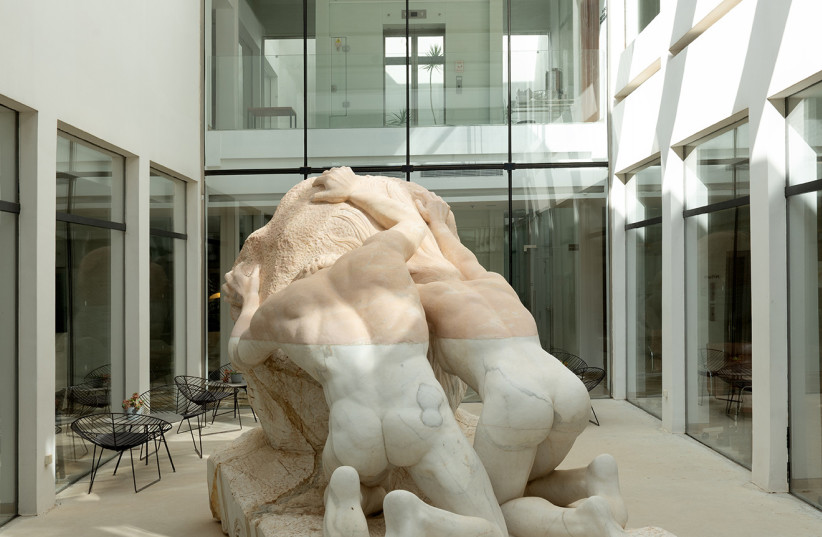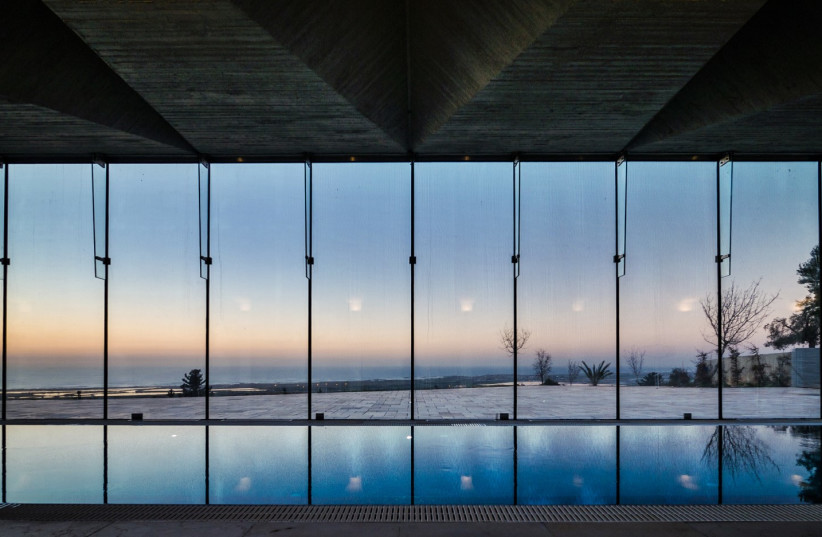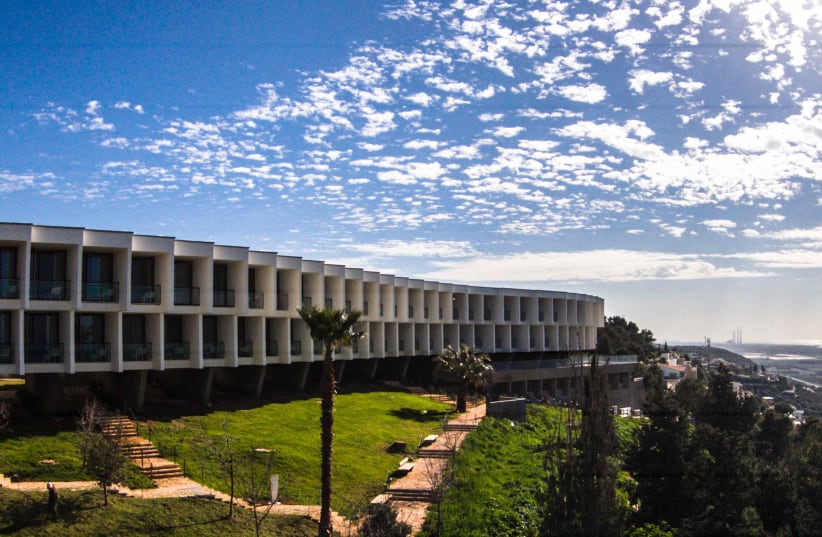Wending like a giant white centipede across the peak of the Carmel Ridge, the Elma Arts Complex Luxury Hotel offers a spectacular view down to the hazy blue Mediterranean, bisected in the middle distance by the black ribbon of the coastal highway, reminding you that you are not quite in the bosom of nature and are more likely to awaken in the morning to the faint swishing sound of distant rubber hitting the tarmac than to birdsong.
But then, Elma does not consider itself a gateway to the sea nor to the countryside. It is a world unto itself, situated behind a guarded gate, not quite part of Zichron Ya’acov and not quite part of the countryside around it.
When we asked for directions to the Elma hotel from the bus terminus in the town center, locals scratched their heads, said it was out of town, and suggested taking a cab. But it turned out to be just a few side streets away, a leisurely 10-minute walk through and beyond picturesque Zichron’s unique but important history.
Around and beyond the history of picturesque Zichron Ya'acov
The Elma is not a place for beachcombers. There is no shuttle to the Dor and Nachshon beaches, but then who needs to sweat through the humid, dusty, and noisy lowland when a microclimate in the hills ensures dry armpits all day?
Without leaving the grounds, you can spend the whole day perusing modern Israeli art which lines all the corridors of the hotel, and even join a guided tour, offered every day at 11 a.m. You can also enjoy a concert in the evening in one of the hotel’s two well-appointed concert halls.


The Israel Camerata Jerusalem arrived the day we were there. The acclaimed chamber orchestra performed an amazingly precocious third symphony by teenage Basque composer Juan Crisostomo Arriaga y Balzola, known as the “Spanish Mozart,” born 50 years to the day after Wolfgang Amadeus. The prodigy died 10 days before his own 20th birthday but was alive during the latter years of Beethoven – surely an inescapable inspiration.
Most members of the audience, seemingly almost entirely secular Zichronites, Haifaites, and Galileans and over 60, were not hotel guests, arriving instead for an evening of old-world culture. But then that is what the Elma was designed to be. It prides itself on advancing musical and artistic culture in Israel.
Of course, those who stayed at the hotel could spend most of the day in the luxuriant outdoor pool which, for the chlorine intolerant, was pleasantly unchlorinated, unusual in Israeli pools, possibly because the Elma is not for small children and is never full. It is quiet, a mecca for young, possibly hi-tech couples, heirs to their Mapai and Mapam grandparents. Teva, the pharmaceutical company, was holding a convention at the Elma during out stay.
The building itself is an artwork, originally designed in 1968 as a sanatorium for overworked and underpaid Histadrut workers. Renowned architect Yaacov Rechter – a son of and a father to architects – won the Israel Prize for his design. He didn’t however, include a swimming pool for the workers nor provide a shuttle to the beach.
His son Amnon renovated the place in 2015, inspired by what he called his father’s “masterpiece.” Amnon’s own specialty is building concert halls, and the Elma’s are more than adequate.
The building was beginning to crumble by the turn of the millennium. The Histadrut, a shadow of its former self as socialism went out of fashion, began selling off its less profitable undertakings – which meant most of them – including The Jerusalem Post, which was one of the first to go in 1990.
But Lily Elstein, with family roots in Zichron and also in Teva, came to the rescue in 2005 with a plan to turn the dilapidated building into an arts complex in which the number of bedrooms would be reduced, and the rooms would be enlarged and technologically upgraded to serve as a luxury guest house – and assume the purpose for which – in its soul – it was always meant: to be: an artistic showpiece. The hotel itself was secondary, it is said – there to serve as its economic backbone.
The hotel is not difficult to get lost in it. The best way to find your room in the sprawling building is by making note of the paintings you pass along your route. However, there are so many, and most are so abstract that it is difficult to distinguish one from the other without careful perusal and individual appraisal. I cannot help thinking that the curators were being a little too progressive in stating their philosophy of art in a note as “anything you can get away with,” signed Andy Warhol. Fortunately, one painting by David Reeb was more colorful and distinctive and served as my compass along the northwest passage.
As a hotel, the Elma gets away with some very easy to fix but dangerous omissions. Shower stalls should have a ledge so that water doesn’t spill onto the ceramic tiles, which become dangerously slippery. If you do slip, don’t expect to find a first aid kit anywhere. Asking for an aspirin at reception elicited the response that the hotel is not authorized to keep drugs. But the technologically challenged might need an aspirin after spending an hour trying to turn on the TV.
Given that the Dor and Nahshon beaches are not readily within reach, it would be nice if, for the less gifted art connoisseurs but more avid swimmers, the great outdoor pool opened before 10 a.m. and closed after 6 p.m., especially a month before and after the year’s longest day. The indoor chlorinated pool – just big enough for two swimmers to pass each other – does open at 6 a.m., albeit without a lifeguard, but is no substitute for the large unchlorinated outdoor pool. The serviceable gym opens at 6 a.m. And breakfast and dinner, unfussily served buffet style, are good, varied, and artistically presented, of course. No one will stop you from going back for refills.
FOR THOSE who venture out of the grounds, there is much to see around the corner in Zichron, a hive of early Zionist history, a healthy reminder that at 141 years old – almost twice the age of the State of Israel, 15 years older than Herzl’s Der Judenstaat, and 36 years older than the Balfour Declaration – Zionism is vintage.
One of the first things that struck us was a row of houses called Emmaus 1, 2, and 3. Our curiosity sparked, we knocked on one of the doors, and all three of the houses turned out to belong to an unusual community of kindly and respected German Lutheran lovers of Israel who serve in the IDF and run a factory producing air filters for sealed rooms. Could it be they are expecting an apocalypse soon?
Whoever wants to understand this country should also take a walk along the cobble-stoned Rehov Hameyasdim to discover Beit Aaronsohn at one end and the First Aliyah Museum near the other, both established at about the same time as Elma.
Try not to be moved by the photos of mostly pious-looking Romanian couples on the wall and the sorry fate of NILI, the acronym for netzah Israel lo eshaker, “the eternal one of Israel will not lie” (1 Sam. 15:29). The family spy ring was credited with enabling the British to conquer Palestine and was snubbed by other Jewish settlers fearful of Turkish reprisals in 1917 Ottoman-governed Palestine. Through a combination of film, archival material, and location in the Orientally decorated and comfortable homestead of the remarkable Aaronsohn family, the story of their inspired but dangerous decision to help the British under the nose of the Turks comes to life.
Zichron was a wild place then – apparently wild boar still roam, I heard from more than one villager – even under the patronage of Edmund de Rothschild, from 1883.
His Carmel Winery is in the town center, and both the village and the local synagogue are named for his father, Jakob Mayer Rothschild (aka Baron James Mayer de Rothschild) not for the biblical Jacob – with Zichron Ya’acov literally meaning “in memory of Jacob.”
Rothschild had a famous falling out with Theodor Herzl when the Viennese journalist came on the scene in 1897. Rothschild eschewed politics in the name of piecemeal settlement, and Herzl said nothing would come of settlement without prior political guarantees from a great power – which at the time he thought was obviously the Ottoman Empire, but which the Aaronsohns divined would be Britain.
But why did the Aaronsohns and a few friends take on the Turks? Hard to tell, but in the photos of the couples in the First Aliyah Museum, it is easy to spot the mother of Aaron Aaronsohn, the guiding hand behind NILI. A quote attributed to Malka Aaaronsohn has her saying, “I will stay here even if I have to gnaw stones,” and one can believe it. When war broke out, her son, driven by loathing of Turkish atrocities against Armenians and Turkish expulsions of Russian Jews, decided to work for the British against the Turks, though for most others fear of Turkish reprisals and uncertainty about the war’s outcome was a good reason to keep one’s head down.


Not so well known is that Aaronsohn, a renowned botanist, was actually on good terms with the infamous Ottoman military leader Ahmed Djemal, also known as Cemal Pasha, one of the three pashas that ruled the Ottoman Empire during World War I. Djemal gave Aaronsohn the freedom of the land to increase grain production for the Turkish army and eliminate locust swarms. Aaronsohn had much to gain from Djemal’s patronage but used it to undermine the Turks, perhaps because he knew more about Turkish activities and intentions than others.
Aaronsohn’s pre-war discovery of wild wheat so impressed British and American statesmen – The New York Times wrote a short article about it when Aaronsohn visited the US in 1912 – that it is no exaggeration to say that he, like Weizmann and his production of acetone from chestnuts for British munitions, converted many an antisemite. In Weizmann and Aaronsohn they saw that with Zionism, Jews alone could really develop the technically challenged land and perhaps inspire development in other destitute lands at the time under imperial sway.
Former Mossad head Ephraim Halevy has said that admiration for Aaronsohn’s scientific prowess, no less than for Weizmann’s, contributed in part to the promulgation of the Balfour Declaration.
Middle East diplomat Mark Sykes, a devout Roman Catholic who came to know and admire both men after fathering and then discarding the discredited Sykes-Picot agreement as far as partitioning Palestine was concerned, gushed in a note he wrote a year before he died, in the 1919 Spanish flu pandemic, that Zionism could be the “forerunner of a greater Zionism. Call of land and scriptures may eventually equal call of human race.”
The Aaronsohns and their friends were instrumental in aiding general Edmund Allenby’s advance through the topography of Palestine in 1917, but alas it all ended in betrayal or negligence two weeks before Allenby reached Beersheba.
Sarah Aaronsohn, 27, shot herself at home after being captured by the Turks, to avoid collaborating under torture. Avshalom Feinberg, planning to marry Sarah’s younger sister, Rivka, had been murdered by Bedouin in Sinai on his way to British HQ in Cairo. A treacherous carrier pigeon with a compromising note attached to its leg flew into a Turkish camp. A cousin of Feinberg carrying a list of NILI members in his pocket who came looking for him was captured. He and another member were hanged in Damascus. And Aaron, who survived, perished in a plane crash two years later.
Elma’s transformation from Histadrut rest home to hi-tech arts complex has an intriguing Israeli history of its own, quite separate from Zichron’s, and the combination of the two is a great two-day education.
The writer was a guest of the Elma Arts Complex and Luxury Hotel.
